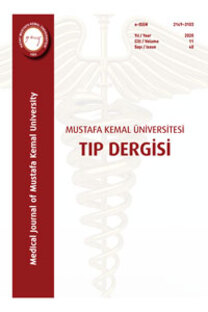Gastrointestinal Stent Uygulamaları: Tek merkez deneyimi
Gastrointestinal stentler, Kendiliğinden genişleyen stentler, SEMS, Palyatif destek
Gastrointestinal Stent Applications: Single center experience
Gastrointestinal stents, Self-expanding stents, SEMS, Palliative support,
___
- Lambert R. An overview of the management of cancer of the esophagus. Gastrointest Endosc Clin N Am 1998; 8: 415-34. https://doi.org/10.1016/S1052-5157(18)30270-8
- Domschke W, Foerster EC, Matek W, Rodl W. Self-expanding mesh stent for esophageal cancer stenosis. Endoscopy 1990; 22: 134-136. https://doi.org/10.1055/s-2007-1012818
- Giral A, Kalaycı C. Özofagusun kanser dışı hastalıklarında cerrahi tedavi. In Yüksel M, Başoğlu A. ed. Özofagus Hastalıklarının Tıbbi ve Cerrahi Tedavisi. 2002: 309-320.
- Tan BS, Mason RC, Adam A. Minimally invasive therapy for advanced oesophageal malignancy. Clin Radiol 1996; 51: 828-836. https://doi.org/10.1016/S0009-9260(96)80078-X
- Eroglu A, Turkyılmaz A, Aydın Y. Özofagus hastalıklarında stent uygulamaları. Turkiye Klinikleri J Thor Surg-Special Topics 2009; 2: 95-99.
- Radecke K, Gerken G, Treichel U. Impact of a self-expanding, plastic esophageal stent on various esophageal stenoses, fistulas, and leakages: a single-center experience in 39 patients. Gastrointest Endosc 2005; 61: 812-8. https://doi.org/10.1016/S0016-5107(05)00290-7
- Sandha GS, Marcon NE. Expandable metal stents for benign esophageal obstruction. Gastrointest Endosc Clin North Am 1999; 9: 437-46. https://doi.org/10.1016/S1052-5157(18)30187-9
- Boulis NM, Armstrong WS, Chandler WF, et al. Epidural abscess: A delayed complication of esophageal stenting for benign stricture. Ann Thorac Surg 1999; 68: 568-70. https://doi.org/10.1016/S0003-4975(99)00591-3
- Adam A, Ellul J, Watkinson AF, et al. Palliation of inoperable esophageal carcinoma: A prospective randomised trial of laser therapy and stent placement. Radiology 1997; 202: 344-348. https://doi.org/10.1148/radiology.202.2.9015054
- Cwikiel W, Tranberg KG, Cwikiel M, et al. Malignant dysphagia: Palliation with oesophageal stents-long term results in 100 patients. Radiology 1998; 207: 513-518. https://doi.org/10.1148/radiology.207.2.9577503
- Sharma P, Kozarek R, Practice Parameters Committee of American College of Gastroenterology. Role of esophageal stents in benign and malignant diseases. Am J Gastroenterol 2010; 105:258. https://doi.org/10.1038/ajg.2009.684
- Wang MQ, Sze DY, Wang ZP, et al. Delayed complications after esophageal stent placement for treatment of malignant esophageal obstructions and esophagorespiratory fistulas. J Vasc Interv Radiol. 2001; 12: 465-474. https://doi.org/10.1016/S1051-0443(07)61886-7
- Kocher M, Dlouhy M, Neoral C, et al. Esophageal stent with antireflux valve for tumors involving the cardia: work in progress. J Vasc Interv Radiol 1998; 9: 1007-1010. https://doi.org/10.1016/S1051-0443(98)70441-5
- Watkinson A, Ellul J, Entwisle K, et al. Oesophageal carcinoma: initial results with covered self expanding endoprostheses. Radiology 1995;195:821-827. https://doi.org/10.1148/radiology.195.3.7538682
- Turkyilmaz, A, Eroglu A, Aydin Y, et al. Complications of metallic stent placement in malignant esophageal stricture and their management. Surg Laparosc Endosc Percutan Tech. 2010; 20; 10-15. https://doi.org/10.1097/SLE.0b013e3181cdebf4
- Homann N, Noftz MR, Klingenberg-Noftz RD, et al. Delayed complications after placement of self-expanding stents in malignant esophageal obstruction: treatment strategies and survival rate. Dig Dis Sci. 2008; 53: 334- 340. https://doi.org/10.1007/s10620-007-9862-9
- Shimi SM. Self-expanding metallic stents in the management of advanced esophageal cancer: a review. Semin Laparosc. Surg. 2000; 7: 9-21. https://doi.org/10.1177/155335060000700103
- ISSN: 2149-3103
- Yayın Aralığı: Yılda 3 Sayı
- Başlangıç: 2010
- Yayıncı: Hatay Mustafa Kemal Üniversitesi Tıp Fakültesi Dekanlığı
Ankilozan Spondilitte Fizik Tedavinin Etkinliği: Randomize Kontrollü Bir Çalışma
Ayşe ÜNAL ENGİNAR, Hatice UĞURLU
Çok Kesitli Bilgisayarlı Tomografi İle Torakal Aortik Varyasyonlarının Değerlendirilmesi
Murat DEĞER, Fatma ÖZTÜRK KELEŞ
Gastrointestinal Stent Uygulamaları: Tek merkez deneyimi
Mustafa Zanyar AKKUZU, Orhan SEZGİN, Fehmi ATEŞ, Osman ÖZDOĞAN, Serkan YARAŞ, Ferzan AYDIN, Hatice RIZAOĞLU BALCI, Enver ÜÇBİLEK, Engin ALTINTAŞ
Mehmet ÖZDİN, Mehmet ÖZDİN, DURHASAN MUNDAN
Yaşlı Hastada Renal Anjiomiyolipomun Selektif Arteriyel Embolizasyonu: Olgu Sunumu
Ömer KORAŞ, Serkan YARIMOĞLU, Ibrahim Halil BOZKURT, Tirdad SETAYESHİ
Tek Endoskopist Deneyimi; ERCP Sonuçları, Komplikasyonlar ve İlgili Faktörler
Minimal İnvaziv Pektus Ekskavatum Ameliyatı: Tek Merkez Deneyimi
Yılan Isırmaları ve Antivenom Tedavisinin Önemi
Mustafa Zanyar AKKUZU, Orhan SEZGİN, Serkan YARAŞ, Osman ÖZDOĞAN, Hatice RIZAOĞLU BALCI, Ferzan AYDIN, Enver ÜÇBİLEK, Engin ALTINTAŞ, Fehmi ATEŞ
